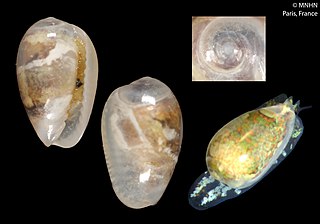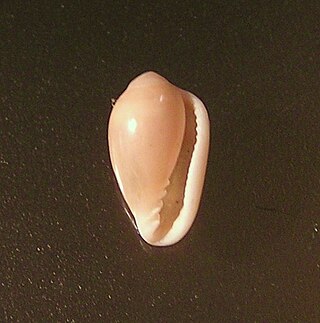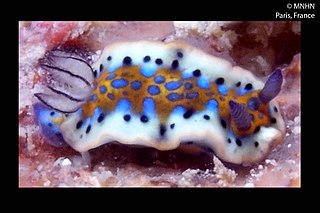
Gibberula is a genus of minute sea snail, a marine gastropod mollusk or micromollusk in the family Cystiscidae, previously placed in the family Marginellidae, the margin shells or marginellids.
Inbiocystiscus is a genus of minute sea snail, a marine gastropod mollusc in the family Cystiscidae.

Eubranchus is a genus of aeolid nudibranch in the family Eubranchidae.

Hyalina is a genus of sea snails, marine gastropod mollusks in the subfamily Pruninae of the family Marginellidae, the margin snails.

Gargamella perezi is a species of sea slug or dorid nudibranch, a marine gastropod mollusk in the family Discodorididae.
Tenellia correai is a species of sea slug, an aeolid nudibranch, a marine gastropod mollusc in the family Fionidae.
Tenellia herrerai is a species of sea slug, an aeolid nudibranch, a marine gastropod mollusc in the family Fionidae.
Tenellia pallida is a species of sea slug, an aeolid nudibranch, a marine gastropod mollusc in the family Fionidae.
Jorunna efe is a species of sea slug, a dorid nudibranch, a shell-less marine gastropod mollusc in the family Discodorididae.
Okenia ameliae is a species of sea slug, specifically a dorid nudibranch, a marine gastropod mollusc in the family Goniodorididae.
Okenia mica is a species of sea slug, specifically a dorid nudibranch, a marine gastropod mollusc in the family Goniodorididae.
Okenia miramarae is a species of sea slug, specifically a dorid nudibranch, a marine gastropod mollusc in the family Goniodorididae.
Anetarca piutaensis is a species of sea slug, specifically an aeolid nudibranch. It is a marine gastropod mollusc in the family Facelinidae.
Nanuca sebastiani is a species of sea slug, specifically an aeolid nudibranch. It is a marine gastropod mollusc in the family Facelinidae. It is the only species of the genus Nanuca.

Pleurobranchus crossei is a species of pleurobranchid sea slug, a type of marine gastropod mollusc
Trapania bajamarensis is a species of sea slug, a dorid nudibranch, a marine gastropod mollusc in the family Goniodorididae.
Aegires sublaevis is a species of sea slug, a nudibranch, a marine, opisthobranch gastropod mollusk in the family Aegiridae.

Felimare fortunensis is a species of sea slug or dorid nudibranch, a marine gastropod mollusc in the family Chromodorididae.
Volvarina artemisae is a species of sea snail, a marine gastropod mollusk in the family Marginellidae, the margin snails.

Mirpurina is a genus of sea snails, marine gastropod mollusks in the subfamily Pruninae of the family Marginellidae, the margin snails.






